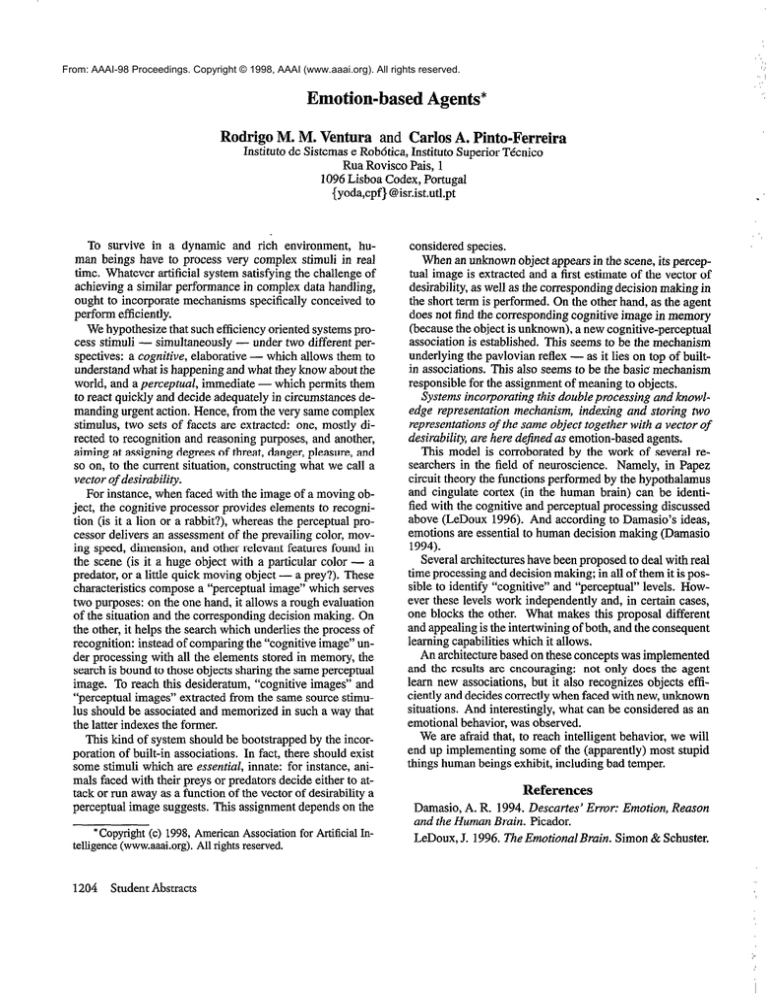
From: AAAI-98 Proceedings. Copyright © 1998, AAAI (www.aaai.org). All rights reserved.
Emotion-based Agents*
Rodrigo M. M. Ventura
and Carlos A. Pinto-Ferreira
Instituto de Sistemase Robdtica,Instituto SuperiorTe’cnico
Rua Rovisco Pais, 1
1096 1---1 ishoa- (Index.
--_---a--,
-Portnod
--_I DI-
(yoda,cpf}@isr.ist.utl.pt
.
To survive in a dynamic and rich environment. human beings have to p>ocessvery complex stimuli in real
time. Whatever artificial system satisfying the challengeof
achieving a similar performancein complex data handling,
consideredspecies.
When an unknown object appearsin the scene,its perceptual image is extractedand a first estimate of the vector of
desirability, as well as the correspondingdecision making in
owht
-. 51--. to
.- incomorate
--.---=-..__ mechanisms
-- .-- _._..--__A. nnecificallv
-r- _.__----,
the &gfi
cnncejv\red_ tc,
perform efficiently.
We hypothesizethat such efficiency orientedsystemsprocess stimuli - simultaneously- under two different perspectives:a cognitive, elaborative- which allows them to
understandwhat is happeningand what they know about the
world, and a perceptual, immediate- which permits them
to react quickly and decide adequatelyin circumstancesdemanding urgentaction. Hence,from the very samecomplex
stimulus, two sets of facets are extracted: one, mostly directed to recognition and reasoningpurposes,and another,
aiming at assigningdegreesof threat, danger,pleasure,and
so on, to the current situation, constructingwhat we call a
vector of desirability.
For instance,when faced with the image of a moving object, the cognitive processorprovides elementsto recognition (is it a lion or a rabbit?), whereasthe perceptualprocessordelivers an assessmentof the prevailing color, moving speed,dimension, and other relevant featuresfound in
the scene (is it a huge object with a particular color - a
predator,or a little quick moving object - a prey?). These
characteristicscomposea “perceptualimage”which serves
two purposes:on the one hand, it allows a rough evaluation
of the situation and the correspondingdecisionmaking. On
the other, it helps the searchwhich underliesthe processof
recognition: insteadof comparingthe “cognitive image”under processingwith all the elementsstored in memory, the
searchis bound to thoseobjects sharingthe sameperceptual
image. To reach this desideratum,“cognitive images”and
“perceptualimages”extractedfrom the samesourcestimulus should be associatedand memorizedin such a way that
the latter indexesthe former.
This kind of system should be bootstrappedby the incorporation of built-in associations.In fact, there should exist
some stimuli which are essential, innate: for instance,animals faced with their preys or predatorsdecide either to attack or run away as a function of the vector of desirability a
perceptualimage suggests.This assignmentdependson the
‘Copyright(c) 1998,AmericanAssociationfor Artificial Intelligence(www.aaai.org).
All rightsreserved.
1204 StudentAbstracts
tcmA
is y----.z..--.
n~rfmtnd
nn
V..
thP
.-A” nther
v.1.w.
had
*...A.-,
RQ thP
~-~omt
.a”
S&A_U~““C
doesnot find the correspondingcognitive image in memory
(becausethe object is unknown), a new cognitive-perceptual
associationis established.This seemsto be the mechanism
underlying the Pavlovianreflex - as it lies on top of builtin associations.This also seemsto be the basic mechanism
responsiblefor the assignmentof meaningto objects.
O..>, _ mcolporanng
. ~... -<. mu
*l . a’oubie processing and knowi3yJrernb
edge representation mechanism, indexing and storing two
representations of the same object together with a vector of
desirability, are here dejined as emotion-basedagents.
This model is corroboratedby the work of several researchersin the field of neuroscience. Namely, in Papez
circuit theory the functions performed by the hypothalamus
and cingulate cortex (in the human brain) can be identified with the cognitive and perceptualprocessingdiscussed
above jieijoux i996j. And according to Damasio’s ideas,
emotionsare essentialto human decision making (Damasio
1994).
Severalarchitectureshavebeenproposedto deal with real
time processingand decisionmaking; in all of them it is possible to identify “cognitive” and “perceptual”levels. However theselevels work independentlyand, in certain cases,
one blocks the other. What makes this proposal different
and appealingis the intertwining of both, and the consequent
iearning capabiiitieswhich it aiiows.
An architecturebasedon theseconceptswas implemented
and the results are encouraging: not only does the agent
learn new associations,but it also recognizesobjects efficiently anddecidescorrectly when faced with new, unknown
situations. And interestingly, what can be consideredas an
emotionalbehavior,was observed.
We are afraid that, to reach intelligent behavior, we will
end up implementingsome of the (apparently)most stupid
things humanbeingsexhibit, including bad temper.
References
Damasio,A. R. 1994. Descartes’ Error: Emotion, Reason
and the Human Brain. Picador.
LeDoux, J. 1996. The Emotional Brain. Simon & Schuster.








![This article was downloaded by:[Gutchess, Angela H.] On: 21 November 2007](http://s2.studylib.net/store/data/014640045_1-88dc6aeb504a95c0e0e57a73d73b7d9b-300x300.png)